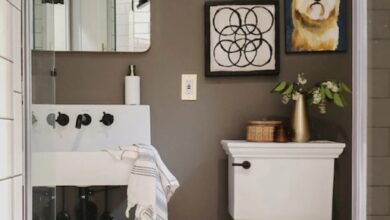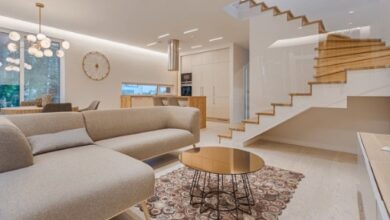Home Office Ideas
In today’s world, a well-designed home office is essential for productivity and comfort. Whether you’re working from home full-time or need a space for occasional use, your home office should be a place that inspires creativity and focus. Here are some home office ideas that can help you create the perfect workspace tailored to your needs.
1. Assessing Your Space and Needs

Before you start planning, take a moment to assess your space and needs:
- Purpose: Will this be a full-time workspace or a part-time retreat?
- Space: How much space do you have available? Do you have a dedicated room, or are you carving out space in another area?
- Budget: How much are you willing to spend on setting up your home office?
2. Choosing the Right Location
1. Dedicated Room:
- A spare bedroom or a basement can be converted into a quiet, private office.
- Consider adding soundproofing if the area is noisy.
2. Shared Space:
- Use a corner of your living room, bedroom, or even a large hallway.
- Create a visual separation with a room divider or a large bookshelf.
3. Outdoor Office:
- If space allows, consider setting up a garden shed or a backyard studio.
- Ensure it’s weatherproof and has proper insulation.
3. Selecting the Right Furniture
1. Desk:
- Choose a desk that fits your space and needs. A large desk is ideal for multiple monitors, while a compact desk works for laptops and minimal setups.
- Consider a standing desk or an adjustable desk to switch between sitting and standing.
2. Chair:
- Invest in an ergonomic chair that provides proper support.
- Look for adjustable height, lumbar support, and comfortable padding.
3. Storage:
- Incorporate shelves, cabinets, and drawers to keep your workspace organized.
- Use floating shelves for additional storage without taking up floor space.
4. Organizing Your Space
1. Declutter:
- Keep only essential items on your desk to reduce distractions.
- Use cable management solutions to keep wires and cords tidy.
2. Storage Solutions:
- Use bins, baskets, and organizers for office supplies.
- Label everything for easy access and maintenance.
3. Filing System:
- Implement a filing system for important documents. Consider digitalizing files to save space.
5. Enhancing Lighting
1. Natural Light:
- Position your desk near a window to take advantage of natural light.
- Use sheer curtains to diffuse harsh sunlight.
2. Task Lighting:
- Use a desk lamp with adjustable brightness for focused lighting.
- Consider LED lights for energy efficiency and longevity.
3. Ambient Lighting:
- Use floor lamps or wall sconces to create a warm, inviting atmosphere.
- Avoid harsh overhead lighting that can cause glare and eye strain.
6. Adding Personal Touches
1. Decor:
- Choose decor that reflects your personality and inspires creativity.
- Use artwork, plants, and decorative items to make the space feel welcoming.
2. Color Scheme:
- Use colors that promote focus and calmness. Blues and greens are known for their calming effects.
- Add pops of color with accessories like cushions, rugs, and stationery.
3. Inspiration Board:
- Create a vision board with motivational quotes, photos, and goals.
- Use a corkboard, magnetic board, or a digital board on your computer.
7. Incorporating Technology
1. High-Speed Internet:
- Ensure you have a reliable and fast internet connection.
- Consider a wired connection for stability, especially for video calls and large file transfers.
2. Tech Gadgets:
- Invest in a good-quality webcam, microphone, and headphones for virtual meetings.
- Use a wireless keyboard and mouse for a clutter-free desk.
3. Dual Monitors:
- Consider using two monitors to increase productivity and multitasking capabilities.
- Use a monitor stand to keep screens at eye level and reduce neck strain.
8. Maintaining Ergonomics
1. Desk Height:
- Ensure your desk is at a comfortable height where your arms are parallel to the floor.
- Use a footrest if your feet don’t touch the ground.
2. Screen Position:
- Place your monitor at eye level to avoid straining your neck.
- Keep the screen about 20 inches away from your face.
3. Posture:
- Sit with your back straight and shoulders relaxed.
- Take regular breaks to stretch and move around.
9. Creating a Healthy Environment
1. Plants:
- Incorporate indoor plants to improve air quality and add a touch of nature.
- Choose low-maintenance plants like succulents or snake plants.
2. Air Quality:
- Use an air purifier to keep the air clean and free from allergens.
- Ensure proper ventilation by opening windows or using fans.
3. Water and Snacks:
- Keep a water bottle at your desk to stay hydrated.
- Have healthy snacks on hand to maintain energy levels.
10. Balancing Work and Relaxation
1. Relaxation Area:
- Set up a small area with a comfortable chair or a bean bag for short breaks.
- Use this space for reading, meditating, or simply unwinding.
2. Break Schedule:
- Follow the Pomodoro Technique or set regular intervals to take short breaks.
- Step away from the screen to rest your eyes and clear your mind.
3. Personal Boundaries:
- Set clear boundaries between work and personal time.
- Avoid working outside of designated hours to maintain a healthy work-life balance.
Conclusion
Creating a home office that combines functionality, comfort, and style can significantly enhance your productivity and well-being. By assessing your needs, choosing the right furniture, organizing your space, and incorporating personal touches, you can design a workspace that meets your unique requirements. Whether you’re working in a dedicated room or a shared space, these ideas can help you create a home office that inspires creativity and focus.




